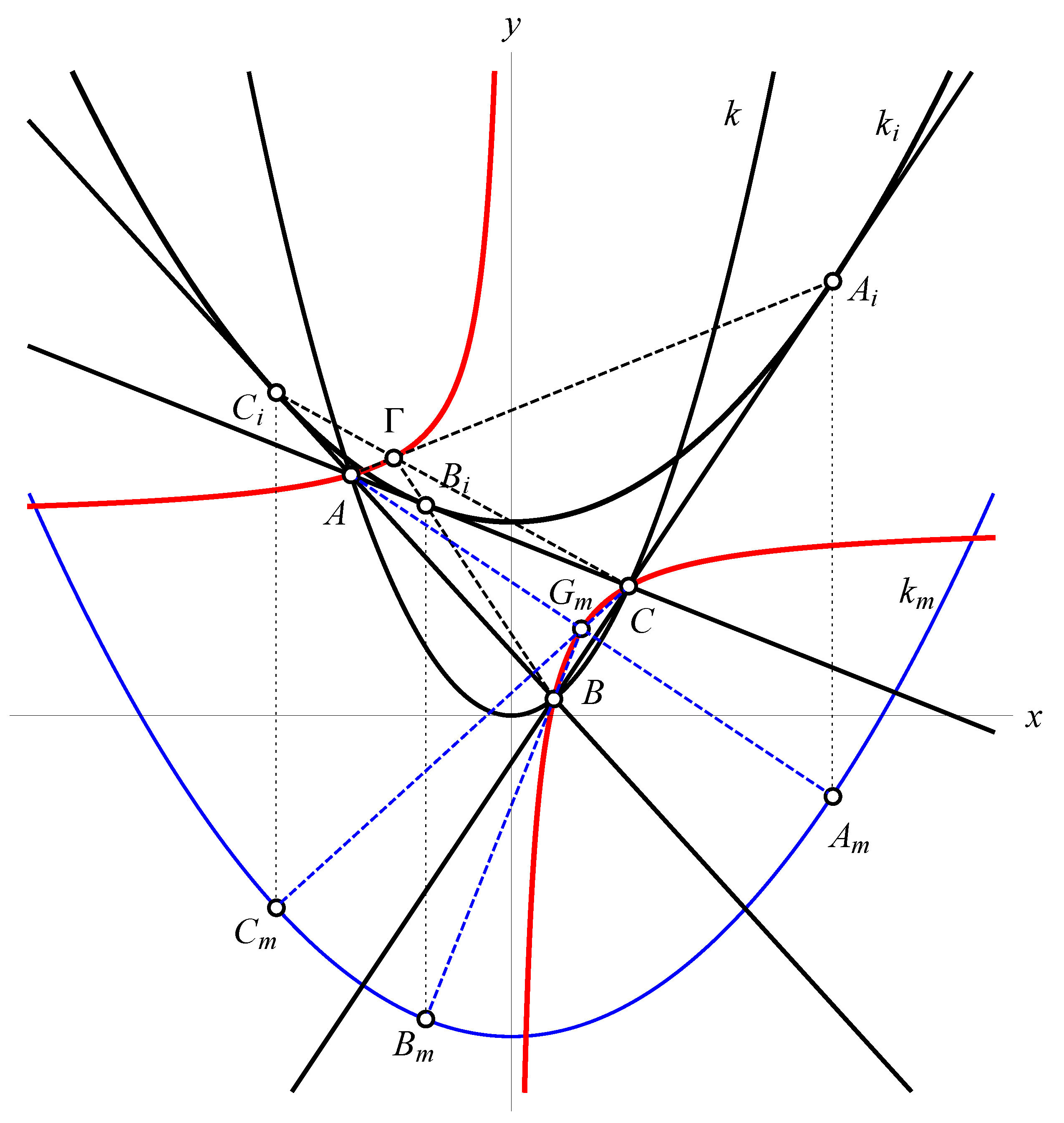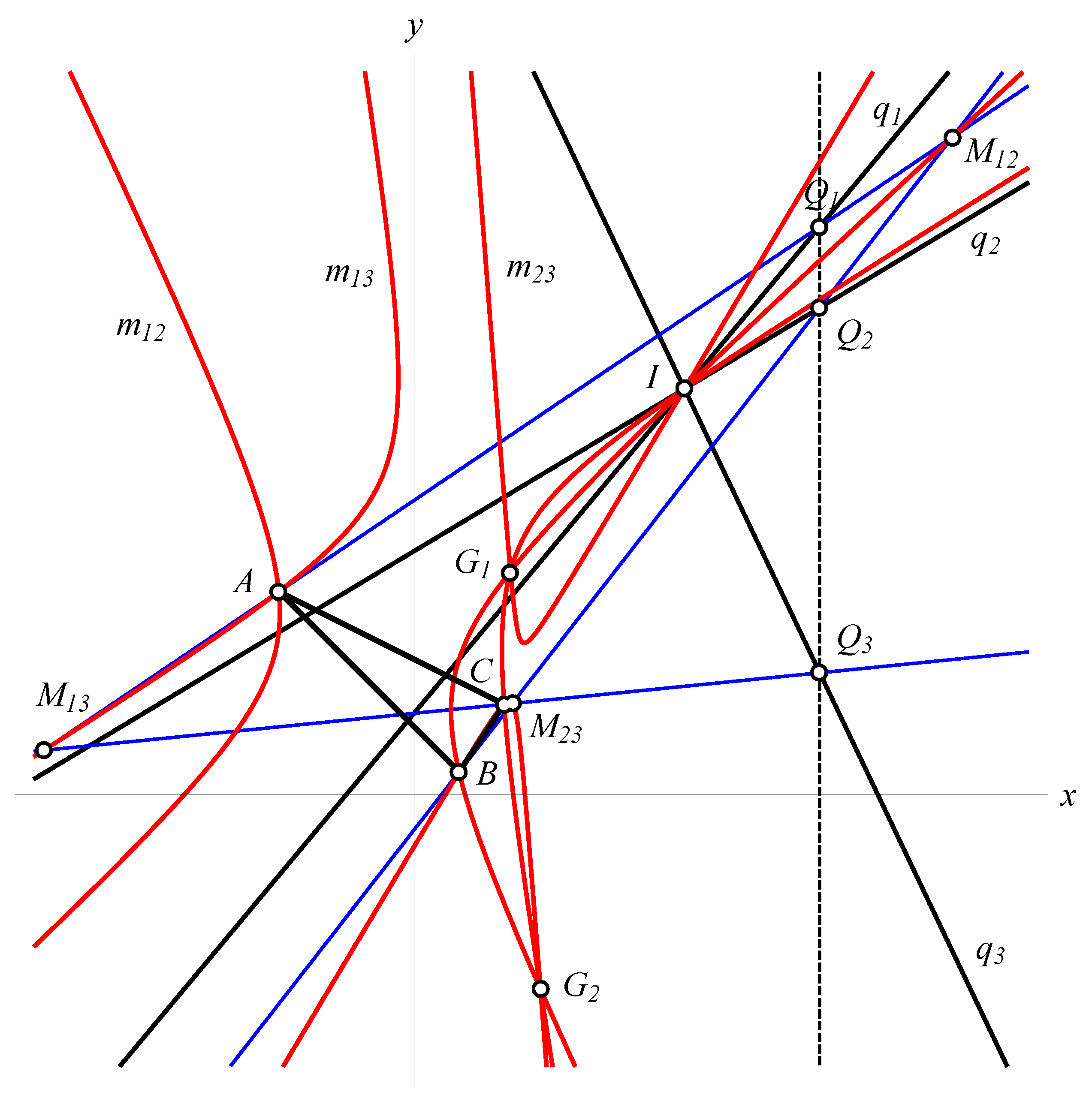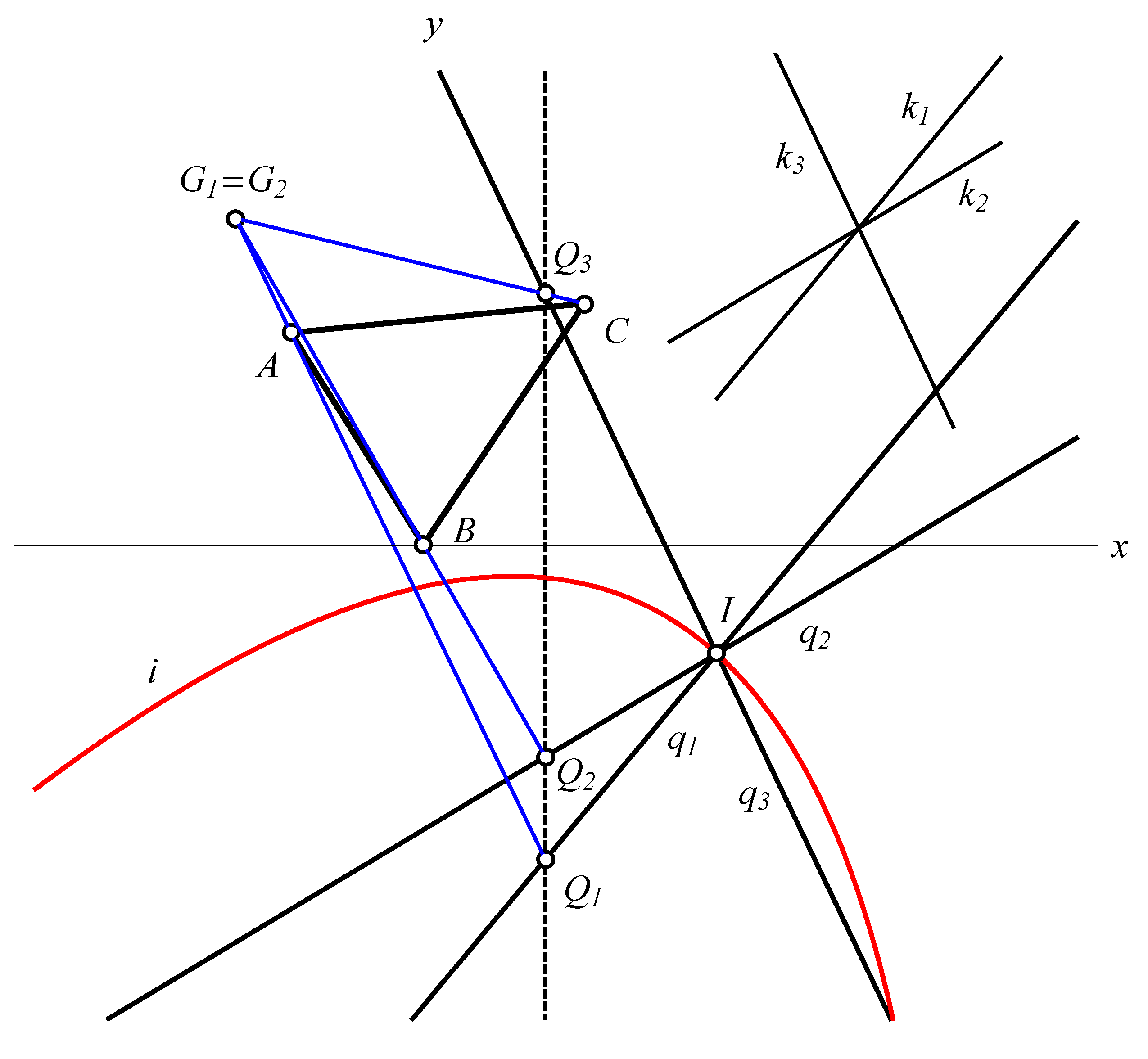1. Introduction
An isotropic plane is a projective plane with an absolute figure
consisting of a real line
f and a real point
. Isotropic lines are all lines incident with
F, and isotropic points are all points incident with
f. Two lines intersecting at an isotropic point are called parallel lines. Analogously, any pair of distinct points joined by an isotropic line is said to be parallel. The standard affine model of the isotropic plane is obtained by setting
for the equation of
f, and
for the coordinates of
F. In this model, the coordinates of points are defined by
,
. The isotropic lines are given by the equations
The points
and
are parallel if
. The isotropic distance
of a pair of non-parallel points is defined by
, as explained in [
1].
We say that a triangle in the isotropic plane is allowable if all its sides are non-isotropic lines. It was shown in [
2] that each allowable triangle can be set in the standard position by choosing an appropriate coordinate system. Such a triangle
is inscribed into the circle with the equation
and has vertices of the form
with
.
The following abbreviations
together with their repercussions
will be useful. In order to prove that some geometric fact is valid for each allowable triangle, it is sufficient to prove it for a standard triangle.
The Gergonne point of a triangle in the isotropic plane was studied in [
3], where it was shown that the incircle (excircle) of the standard triangle
has the equation
and the contact points are given by
The common intersection point
of the lines
,
, and
is called the
Gergonne point of the triangle
.
We study some curves related to the Gergonne point in the isotropic plane, and we present a sort of generalizations of the Gergonne point in the Euclidean case.
3. Results
Let
be the pencil of circles
with the equation of the form
where
. The inscribed circle
belongs to the pencil
.
Theorem 1. Let be the standard triangle, its contact triangle, and a circle of the pencil given by the Equation (7). Let be the points of parallel to , respectively. The lines , , are concurrent at a point . When the circle runs through the pencil , the points form a special hyperbola.
Proof of Theorem 1. The points
parallel to
have the coordinates
Therefore, the lines
,
,
have the equations
They all pass through the point
Indeed, the calculation gives a proof for the line .
All points
lie on the conic
which is according to [
1], a special hyperbola, see
Figure 1. □
The point from Theorem 1 can be called the generalized Gergonne point for the triangle and the circle .
The Gergonne point of the triangle is identical to .
The locus of generalized Gergonne points also passes through the vertices of the triangle since , , and .
In [
5,
6], the authors gave some further generalizations of the concept of Gergonne point in the Euclidean case. Here, we study some analogues of these results in the isotropic case.
Theorem 2. Let be the standard triangle, I a point in the isotropic plane and three lines through I. There are at most two values such that for points on with , the lines and are concurrent.
Proof of Theorem 2. Let
I be given by the coordinates
, and let
have the equations
,
. All points
T such that
lie on the isotropic line with the equation
. Therefore, points
have coordinates
, see
Figure 2.
Let
,
,
. Some trivial but long calculations deliver the following values of
d for which these three points coincide
where
The numbers are real and different, real and identical, or a pair of complex conjugate numbers depending on the value of . □
The values determine the points , the common points of the lines , and . The points and can be real and different, complex conjugate, or coinciding depending on the value of . They are called generalized Gergonne points for the triangle and point I and lines , , , through it.
Remark: By eliminating the parameter
d from the first two equations of (
9), we obtain the equation
It represents the locus
of points
when
d runs through
. The curve
is obviously a conic. In the same manner, we conclude that the loci of
and
are conics as well. According to Theorem 2, three loci
,
and
share two further common points
except the fixed point
I, see
Figure 2.
Note that, if directions
are given,
from (
10) is a quadratic function of
. This means that there will be two, one, or none real points
depending on whether the point
I is located outside, on or inside the conic
i with the equation
, see
Figure 3.
Now, we can also state:
Theorem 3. Let be the standard triangle and three directions. All points I for which there is a unique value such that for points on lines in directions with the lines , and are concurrent lie on a parabola.
Proof of Theorem 3. It is left to prove that the conic
i with the equation
is a parabola. After replacing
with
and introducing notations
the terms of the highest degree in the equation of
i are
Thus, the conic i touches the absolute line in one point, the isotropic point of the line . □
4. Discussion and Conclusions
This study gives a contribution to the very rich base of triangle properties in the isotropic plane. We have proved that for a triangle and its contact triangle , there is a pencil of circles such that for each circle from the pencil the lines , , are concurrent at a point , where , , are points on parallel to , respectively. When runs through , the generalized Gergonne points form a special hyperbola.
Further on, to each triangle , a point I and three lines through I we have associated three conics intersecting at I and two generalized Gergonne points and . The existence of and follows from the existence of two values d such that for points on with the lines and are concurrent. For arbitrary directions, the points I, such that coincide, lie on a parabola.
In the papers [
7,
8], the authors studied some further curves related to Gergonne points; they studied the loci of Gergonne points in different pencils of triangles in the isotropic plane. Hence, this paper completes the investigations given there.








